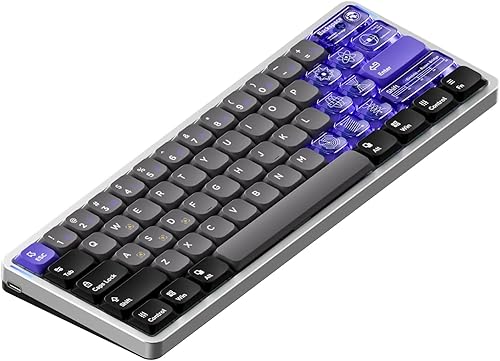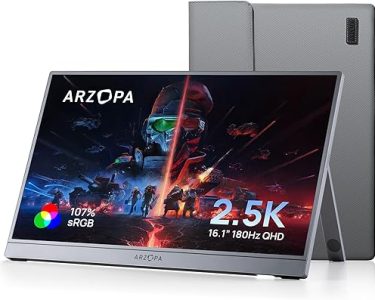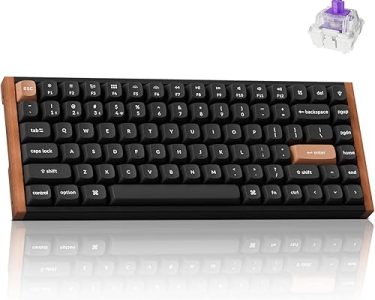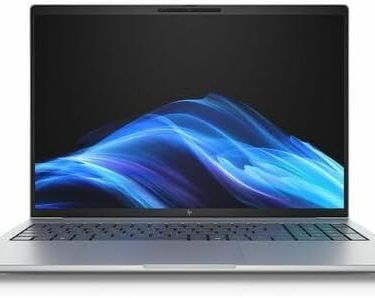The gamers have made their voices heard: they want actuation that can be adjusted. Perhaps none is as spectacular as this one, but the feature is becoming available on an increasing number of keyboards in an increasing number of form factors. This new version of Nuphy’s vibrant low-profile designs, the Air60 HE, comes with magnetic switches.
With one notable exception, this slick tiny keyboard aims to have everything. And if it does not work, damned if it does. It might become your new favorite if you can live without wireless or strong software support, particularly if you are looking for a gaming keyboard that you can carry in your bag.
Design
Alright, I can not continue without complimenting this thing’s visual design. With its multicolored keycaps, the Air series was already quirky, but the HE version takes it a step further by including some translucent caps for a touch of 90s flair. The Game Boy Advance and the Cybiko come to mind, and I am amazed if you can identify those without consulting Wikipedia.
The visuals aren’t going to appeal to everyone — it’s a long way from Razer and Corsair’s sleek stealth or Logitech’s more button-down office stuff. If you’re not a fan, you can replace them with low-profile keycaps, which aren’t as easy to find as standard MX-compatible ones but should still offer plenty of options. But if you like them as much as I do, especially in conjunction with the RGB lighting, you won’t want to.
Little RGB light strips adjacent to the Escape and Backspace buttons add to the vibrant keycaps. Although they can convey basic keyboard status, these are more ostentatious than useful. Once more, I appreciate how the purple keyboard feet (dual-stage, excellent!) match the keycaps, and the case’s bottom is semi-translucent black in contrast to the aluminum top frame. The final chic touch is a reflective badge.
The USB-C port is located in an odd location for a keyboard—around the left edge. Additionally, you will become rather accustomed to that peculiar positioning because this board is wired-only. The only other physical interaction component is a three-way switch on the upper edge, across the corner. Once more, this is not the power switch that it initially looks to be because it is a wired-only board. It allows you to switch between only three pre-programmed layouts.
Wireless, where are you?
Yes, the Air60 HE has just as much wireless capability as an Air Jordan, even if it still uses the “Air” name from its wireless predecessor. (Well, unless you include the laces, I suppose sneakers are wireless in theory.) Given how little and slender this vehicle is, nearly urging you to take it on a road trip, it is an intriguing choice. However, there are two significant benefits to this choice. First of all, like a child playing Fortnite on their mother’s phone, adjustable actuation keyboards can drain battery life. It makes logical to just eliminate wireless and battery concerns from the equation, especially given the compact frame and significantly reduced internal battery space.
Second, gamers have a slight obsession with latency and speed, two aspects that are made more difficult by wireless connections. With 8K polling, you will need to be superhuman to detect any latency when you plug in a USB-C cable. This is especially crucial given the quick motions made possible by customizable actuation.

Nuphy Air60 HE Magnetic Switch Gaming Keyboard,61 Keys Wired Keyboard
This is not to imply that there are no problems with the USB-C cable. If you are a southpaw and use your left hand to control a mouse, the location of the right side is at best awkward and at worst crippling. I could attribute this to a stylistic decision, but because the only somewhat larger Air75 HE doesn’t, I believe it is most likely a constraint of the keyboard’s small and intricate circuit board.
All things considered, this keyboard is remarkable in both its diminutive size and its distinctive visual style. I am tempted to remark that if you wish to add Hall effect capability to a laptop or tablet, it will still make a wonderful travel companion even though being wired (and having an odd cable arrangement) is not ideal for adjusting to travel. Your alternatives are either much bigger or too power-hungry to be useful. or both.
Fewer options and a lower profile
Okay, enough hesitancy on the actual design. The hall effect switches, which allow for adjustable actuation, are the primary distinction between the Air HE keyboards and their non-HE predecessors, aside from the fact that they are wired. In contrast to a typical keyboard’s binary on/off state, the Hall effect uses a magnetic sensor beneath each key to determine how deeply it is depressed. In addition to several additional tactics that are mostly helpful for games, this makes it simple to adjust the pressure at which each key must be pressed.
Low-profile switches and adjustable actuation are not often seen together, at least not yet. I should note, however, that the Gateron switches Nuphy is utilizing here are quite exceptional; their 3.3mm travel distance puts them very nearly full-size (a typical Cherry MX switch has a 4.0mm travel distance). To put it simply, compared to other low-profile boards, typing on this keyboard feels a lot more like using a full-sized mechanical keyboard.
To use a technical phrase, Hall effect keyboards and other designs that allow customizable actuation are intricate and delicate. Although you may use them just like any other keyboard, you will need some smart software to tailor the experience and make the most of that hardware.
The Air60 HE, like other Nuphy boards, is programmed using a browser tool rather than a separate driver or manager application. Since the cross-platform VIA cannot handle adjustable actuation, Nuphy created its version, NuphyIO. It is also quite good given the constraints of a browser-based programming tool! The standard lighting, macro, and key binding settings are included, along with a surprisingly wide range of the latter. None of them ever intimidated or perplexed me. However, consider that I have examined hundreds of keyboards.
However, the “Trigger Settings” section, which contains all the delicious settings for the magnetic switches, is the most important component of this system. You can adjust the incredibly fast Rapid Trigger mode for each key with changes as small as 1mm and alter the actuation point for each key, either alone or with a multi-selection tool. (This is controversial and what Razer refers to as “Snap Tap.” You have received a warning.)
Additionally, you can program a single key to do two distinct actions when pressed and released, or four distinct actions depending on various actuation and release positions. Even if I had the finger dexterity to accomplish this, I honestly can not think of a reason why I would want to. For instance, you can program the “P” key to type “poop” with a literal button press by sending a “P” stroke at 1mm, a “O” at 3mm, a second “O” at the 3mm release point, and a second “P” at the 1mm release point. Poop. I did it there. A macro on a standard keyboard might likewise be used for this. Fantastic.
Gaming and typing
Although I admit that I am not particularly interested in the Air60 He is actuation power adjustments, I am curious about how well its switches work. They are excellent. They feel even more like full-sized keyboards because, as I mentioned before, they have an even greater travel distance than the modified Gateron switches in the other Air keyboards. It is slightly stiffer than a super-premium custom board but far less so than the ultra-thin Lofree Edge because there is no gasket mount.
This is by far the most comfortable low-profile board I have ever used, and I could spend hours typing on it. I should mention that the Jade Pro magnetic switches that Nuphy provided me were already installed on my keyboard; the only noticeable distinction between them and non-Pro Jade is a slightly stiffer spring. The $20 upsell does not seem worth it.
Because they are more complicated and have more parts to click and clack, adjustable actuation keyboards also tend to be louder than conventional mechanical keyboards. However, Nuphy appears to have considered this with well-chosen silicone and foam layers. It is not as quiet as a completely “silenced” mechanical keyboard, but it is still quite acceptable in a coffee shop or office; for example, it is not much noisier than the keyboard on my Dell work laptop.
On a business trip to New York, I was so delighted with the typing experience that I packed it in my bag instead of using my regular phone keyboard, the Keychron K9 Pro. The nearly ubiquitous USB-C standard made it operate flawlessly but with a few added complications.
For wireless, I would be tempted to take the switches from the Nuphy and install them in the Keychain. However, no. These magnetic switches lack electrical contacts within the switch itself, even though the stem and body appear to be nearly identical to conventional low-profile patrons. Therefore, not only will they not be compatible with any other keyboards (at least not yet), but they will also not be compatible with any other Gateron low-profile switches other than the Jade and Jade Pro.
Even with the already constrained range of low-profile switches, it significantly reduces the usefulness of having any sort of hot-swap capability. However, I suppose it is good to have the choice of whether or not Gateron will continue to produce switches in this extremely limited market.
The board gaming is also quite good. As previously said, I only use the adjustable actuation for a small amount of functional testing. However, hours of trouble-free gaming are made possible by the switch’s increased travel distance and the incredibly comfortable cushioning (as long as I have a wrist rest). The absence of a function row may be restrictive for gamers who require additional physical keys without depending on layers. The Air75 HE has a 75% layout version, so do not worry. The base model costs just $10 extra.
Conclusion
I wasn’t expecting to like the Air60 HE as much as I do, since I am a known skeptic for adjustable actuation. But darn it if it isn’t an excellent keyboard even without that extra functionality, with a funky style that appeals to me. And losing wireless capability versus the other Air boards, though it pains my minimalist heart, makes sense if you’re targeting gamers who want those powers.
It is a little pricy at $120 for the basic switches; other low-profile designs with hot-swap Gateron switches are available for a little less money, and they also do not have the hall effect and are wireless. Additionally, this board is somewhat of a luxury option in the world of low-profile boards because there are only two switch options, and the almost identical Jade Pro option comes with an unexpected $30 premium.
Nevertheless, for an adjustable actuation board, $120 is still a low threshold. Corsair’s is $230, Razer’s is $180, and even the revolutionary Wooting is $175. If you do not require more than three keyboard profiles, Nuphy’s stylish tiny competitor is a great value. And you may.
Therefore, a few features of the Nuphy Air60 HE and its larger version, the Air75 HE, may dissuade you from considering them: they only have three profiles, no wireless, and no hot-swap possibilities. However, they are wonderful in every other way. You will discover that they are well worth the cost if you can overlook those problems in favor of excellent typing and a tiny, fashionable style.




